福岡・博多の地に780年以上にわたって受け継がれる伝統工芸品、博多織。その中でも、着物愛好家から絶大な信頼を寄せられているのが「博多帯」です。一度締めれば緩むことのない、その確かな締め心地と、時代を超えて愛される洗練されたデザインは、多くの人々を魅了し続けています。なぜ博多帯は、これほどまでに特別な存在なのでしょうか。
その秘密は、単なる美しさだけではありません。武士の時代から現代に至るまで、実用性を追求し続けた歴史、柄に込められた人々の願い、そして職人たちの卓越した技術が、一本の帯の中に凝縮されています。この記事では、知っているようで知らなかった博多帯の奥深い世界へとご案内します。
- 「献上柄」に隠された物語: 多くの人が目にしたことのある象徴的なデザイン。そこに込められた厄除けや家内安全の願いを解き明かします。
- キュッと締まる心地よさの秘密: 「絹鳴り」と呼ばれる独特の音と共に、なぜ博多帯は緩まないのか。その秘密は独自の織りの構造にありました。
- 伝統から日常へ: 帯という枠を超え、現代のライフスタイルに溶け込む博多織の新たな挑戦と、その多彩な広がりを紹介します。
博多織の源流と武士たちの実用美
博多織の歴史は、鎌倉時代にまで遡ります。1241年、博多の商人であった満田弥三右衛門(みつた やそうえもん)が、宋(当時の中国)から織物の技術を持ち帰ったことがその起源とされています。当初は「唐織」と呼ばれたこの織物は、異国情緒あふれる美しいものでした。
その後、時代は流れ江戸時代。筑前福岡藩の藩主となった黒田長政が、幕府への献上品としてこの博多織を選んだことで、その名は全国に轟くことになります。この時、献上品の柄として定められたのが、現在も博多織の象徴とされる「献上柄」です。
武士たちは、重い刀を腰に差していても帯が緩むことのない、この固く丈夫な博多帯をこぞって愛用しました。実用性から生まれた評価が、博多帯のステータスを確固たるものにしたのです。「帯は博多」。その言葉は、武士たちの間で品質の証として語り継がれました。
粋な「献上柄」と緩まない締め心地
博多帯の代名詞ともいえるのが、独特の幾何学模様で構成された「献上柄」です。このデザインは、仏具である「独鈷(どっこ)」と「華皿(はなざら)」をモチーフにしています。独鈷は煩悩を打ち砕く密教法具であり「厄除け」を、華皿は仏の供養の際に花を散布する器であり「清浄」を意味します。
さらに、これらのモチーフと組み合わされる縞模様にも意味が込められています。太い線が親を、細い線が子を表す「親子縞」は家内安全を、太い線の間に細い線を挟んだ「孝行縞」は子孫繁栄の願いを表しているのです。
この美しい柄だけでなく、博多帯の最大の魅力はその締め心地にあります。多くの細い経糸(たていと)に、数本の糸を撚り合わせた太い緯糸(よこいと)を力強く打ち込むことで、独特の厚みと張り、そしてコシが生まれます。この緻密な織りのおかげで、一度締めると「キュッ」という心地よい絹鳴り(きぬなり)の音を立て、一日中緩むことがありません。この信頼感が、古くは武士に、現代では力士にも愛用される所以なのです。
伝統の織りが生み出す新たな価値
780年以上の歴史を持つ博多織ですが、その技術とデザインは決して過去のものではありません。現代の職人たちは、伝統を守りながらも、新しい感性を取り入れたモノづくりに挑戦し続けています。
例えば、従来の献上柄にとらわれない、モダンでカラフルなデザインの帯が次々と生み出されています。これにより、古典的な着物だけでなく、現代的なファッションにも合わせやすい帯として、若い世代からも注目を集めるようになりました。
さらに、博多織の用途は帯だけに留まりません。その丈夫で美しい生地の特性を活かし、バッグや財布、名刺入れ、ネクタイといった現代のライフスタイルに合わせた様々な製品が開発されています。伝統的な献上柄をあしらった小物は、日常の中にさりげなく和の粋を取り入れることができるアイテムとして、国内外で人気を博しています。
受け継がれる技と未来への展望
博多帯の品質は、博多織工業組合によって厳しく管理されており、認定された製品には品質を証明する証紙が貼られます。例えば、絹を50%以上使用した製品には金色の証紙が、手機(てばた)で織られた製品には特別な証紙が与えられ、その価値を示しています。
福岡市では、後継者育成のための学校が開校されるなど、未来へとこの素晴らしい伝統技術を繋いでいこうという取り組みも活発です。武士の時代から現代まで、人々の暮らしに寄り添い、進化を続けてきた博多帯。その一本一本には、歴史、技術、そして未来への想いが織り込まれているのです。
解説ポイント①:献上柄に隠された物語
博多帯を象徴する「献上柄」は、単なる美しいデザインではありません。そのルーツは江戸時代、筑前福岡藩主・黒田長政が徳川幕府へ献上したことに由来します。柄は主に3つのモチーフで構成されています。
- 独鈷(どっこ): 密教法具の一つで、煩悩を破砕し、菩提心を表すといわれています。このことから「厄除け」の願いが込められています。
- 華皿(はなざら): 仏の供養の際に花を散らすのに用いる器。場を清め、身を清める「清浄」の意味を持ちます。
- 縞(しま):
- 親子縞: 太い一本線と細い二本線で構成され、親が子を守る姿を象徴し、「家内安全」を表します。
- 孝行縞: 細い二本線の間に太い一本線が入っており、子が親を敬う姿になぞらえ、「子孫繁栄」を意味します。
これらの柄を組み合わせた献上柄は、持ち主の安寧と繁栄を願う、お守りのような意味合いを持っていたのです。特に、古代中国の五行説に基づいた「紫・青・赤・黄・紺」の五色で織られる「五色献上」は、それぞれの色に「徳・仁・礼・信・智」という意味が込められ、最も格調高いものとされています。
解説ポイント②:キュッと締まる心地よさの秘密
博多帯が「一度締めたら緩まない」と評される理由は、その独特な製織方法にあります。
- 高密度の経糸(たていと): まず、帯の縦方向の糸である経糸を非常に多く、密に配置します。一般的な織物よりもはるかに多い、数千本もの細い絹糸が使われます。
- 太い緯糸(よこいと): 次に、横方向の糸である緯糸には、細い糸を数本束ねて一本にした、太い糸を用います。
- 強い打ち込み: 織り上げる際、この太い緯糸を筬(おさ)という道具で力強く打ち込みます。この工程により、経糸が緯糸を包み込むように織り上がり、生地に強い張り(ハリ)とコシが生まれます。
この結果、経糸の摩擦抵抗が非常に高くなり、帯を締めた際に生地同士がしっかりと食い込み、緩みにくくなるのです。帯を締める時に聞こえる「キュッ、キュッ」という音は「絹鳴り」と呼ばれ、高密度に織られた博多織ならではの、良質な締め心地の証とされています。この実用性の高さこそが、時代を超えて博多帯が選ばれ続ける最大の理由と言えるでしょう。
解説ポイント③:伝統から日常へ
博多織の活躍の場は、もはや着物の帯だけに限定されていません。その高い耐久性と美術性は、現代の様々なプロダクトに新たな命を吹き込んでいます。
- ファッション小物: 博多織の生地を使ったバッグや財布、名刺入れは、その代表例です。伝統的な献上柄は、モダンなレザーと組み合わせることで、斬新かつ上品な印象を与えます。また、献上柄をデザインしたネクタイも、ビジネスシーンで個性を発揮するアイテムとして人気があります。
- ライフスタイル雑貨: さらに、扇子の扇面に博多織を用いたものや、ブックカバー、ストラップなど、日常的に使える小物も数多く作られています。これらの製品は、伝統工芸をより身近に感じさせてくれるだけでなく、大切な人への贈り物としても選ばれています。
- 異業種とのコラボレーション: 神戸の老舗サンダルメーカーとコラボレーションしたビーチサンダルのように、他分野の製品と博多織を組み合わせる試みも行われています。
こうした現代的な展開は、博多織の新たなファン層を開拓し、伝統産業の活性化に繋がっています。780年以上の時を経て、博多織は日本の「粋」を世界に発信するブランドとして、その可能性を広げ続けているのです。
参考文献
- 博多織について|博多織 サヌイ織物(福岡市)
- 博多織とは。幕府の御用達から庶民にまで広がった織物の歴史と現在 | 中川政七商店の読みもの
- 献上柄(けんじょうがら)|博多祇園山笠用語辞典
- 工房探訪 博多織|きものコンシェルジュ – Ruruto(るると)
- 博多織 | 旅の特集 | 【公式】福岡県の観光/旅行情報サイト「クロスロードふくおか」
【English Article】
【Hakata-obi】 Weaving a Millennium of Style: Unveiling the Beauty and Function of the Hakata-obi
For over 780 years, the city of Fukuoka-Hakata has been home to Hakata-ori, a traditional craftwork. Among its creations, the “Hakata-obi” (Hakata sash) has earned the unwavering trust of kimono enthusiasts. Its reliable fit, which never loosens once tied, and its sophisticated designs that transcend eras continue to captivate many. But what makes the Hakata-obi so special?
The secret lies beyond mere beauty. It is a condensation of history in pursuit of practicality from the age of the samurai to the present day, the wishes embedded in its patterns, and the outstanding techniques of its artisans, all woven into a single sash. This article will guide you through the profound world of the Hakata-obi, a world you thought you knew, but is deeper than you imagine.
- The Hidden Story in the “Kenjo” Pattern: We will decipher the wishes for protection from evil and family safety embedded in the iconic design that many have seen.
- The Secret to a Firm, Comfortable Fit: Along with the distinctive sound known as “kinu-nari” (the rustle of silk), why does the Hakata-obi not loosen? The secret lies in its unique weaving structure.
- From Tradition to Daily Life: We introduce the new challenges and diverse expansion of Hakata-ori as it transcends the framework of the obi to blend into modern lifestyles.
The Origins of Hakata-ori and the Practical Beauty of the Samurai
The history of Hakata-ori dates back to the Kamakura period. Its origins are traced to 1241 when a Hakata merchant named Yasouemon Mitsuta brought back weaving techniques from the Song Dynasty in China. This textile, initially called “Kara-ori,” was beautiful with an exotic flair.
Later, during the Edo period, the lord of the Chikuzen Fukuoka Domain, Nagamasa Kuroda, selected this Hakata-ori as a tributary gift to the shogunate, making its name famous throughout Japan. The pattern designated for this tribute was the “Kenjo pattern,” which remains the symbol of Hakata-ori today.
Samurai warriors, who needed their sashes not to loosen even with heavy swords at their waists, favored this firm and durable Hakata-obi. This reputation, born from practicality, solidified the status of the Hakata-obi. The phrase “For an obi, Hakata is the one” was passed down among samurai as a mark of quality.
The Chic “Kenjo Pattern” and a Fit That Never Loosens
Synonymous with the Hakata-obi is the “Kenjo pattern,” composed of unique geometric designs. This design is based on motifs of Buddhist ritual items: the “dokko” (a single-pronged vajra) and the “hanazara” (a plate for scattering flowers). The dokko, a tool of esoteric Buddhism that shatters worldly desires, symbolizes “protection from evil,” while the hanazara, a vessel used for scattering flowers in Buddhist services, signifies “purity.”
Furthermore, the stripes combined with these motifs are also imbued with meaning. The “oyako-jima” (parent-and-child stripes), with its thick line representing a parent and thin lines representing children, symbolizes family safety. The “koko-jima” (filial piety stripes), with a thick line sandwiched between thin lines, expresses the wish for prosperity of descendants.
Beyond this beautiful pattern, the greatest appeal of the Hakata-obi is its comfortable fit. By forcefully driving thick weft threads (yokoito), made by twisting several thin threads together, into a dense warp of many thin threads (tateito), a unique thickness, firmness, and resilience are created. Thanks to this meticulous weaving, when the obi is tied, it produces a pleasant rustling sound called “kinu-nari” and does not loosen all day. This reliability is why it was favored by samurai in the past and is still used by sumo wrestlers today.
New Value Created by Traditional Weaving
While Hakata-ori has a history of over 780 years, its techniques and designs are by no means relics of the past. Modern artisans continue to take on the challenge of creating new products with a fresh sensibility while preserving tradition.
For example, new obi with modern and colorful designs, not bound by the conventional Kenjo pattern, are being created one after another. This has made them popular not only with traditional kimonos but also with modern fashion, attracting attention from younger generations.
Furthermore, the use of Hakata-ori is no longer limited to obi. Utilizing the characteristics of its durable and beautiful fabric, various products tailored to modern lifestyles, such as bags, wallets, business card holders, and neckties, are being developed. Accessories featuring the traditional Kenjo pattern are gaining popularity both in Japan and abroad as items that allow one to casually incorporate Japanese elegance into daily life.
Inherited Skills and a Vision for the Future
The quality of Hakata-obi is strictly managed by the Hakata-ori Industrial Association, and certified products are marked with a seal of quality. For instance, products using 50% or more silk are given a gold seal, and those woven on a hand-loom receive a special seal, indicating their value.
In Fukuoka City, there are active efforts to connect this wonderful traditional technique to the future, such as the opening of schools for training successors. From the age of the samurai to the present day, the Hakata-obi has evolved alongside people’s lives. Each and every sash is woven with history, technique, and a vision for the future.
## Analysis Point ①: The Hidden Story in the “Kenjo” Pattern
The “Kenjo pattern,” symbolic of the Hakata-obi, is not merely a beautiful design. Its roots lie in the Edo period when it was presented as a tribute to the Tokugawa shogunate by Nagamasa Kuroda, the lord of the Chikuzen Fukuoka Domain. The pattern is primarily composed of three motifs:
- Dokko (Vajra): A ritual object in esoteric Buddhism said to shatter worldly desires and represent the enlightened mind. From this, it carries a wish for “protection from evil.”
- Hanazara (Flower Plate): A vessel used for scattering flowers during Buddhist memorial services. It signifies “purity,” purifying the place and the self.
- Shima (Stripes):
- Oyako-jima (Parent-and-Child Stripes): Composed of one thick line and two thin lines, it symbolizes a parent protecting a child, representing “family safety.”
- Koko-jima (Filial Piety Stripes): With one thick line between two thin lines, it is likened to children respecting their parents, signifying “prosperity of descendants.”
The Kenjo pattern, combining these motifs, acted as a charm, carrying wishes for the owner’s peace and prosperity. In particular, the “Goshiki-kenjo” (Five-Colored Kenjo), woven in the five colors of purple, blue, red, yellow, and navy based on the ancient Chinese theory of the Five Elements, is considered the most prestigious, with each color embodying the virtues of “virtue, benevolence, propriety, faith, and wisdom.”
## Analysis Point ②: The Secret to a Firm, Comfortable Fit
The reason the Hakata-obi is praised for “never loosening once tied” lies in its unique weaving method.
- High-Density Warp Threads (Tateito): First, the vertical threads of the obi, the warp, are arranged very numerously and densely. Many thousands of thin silk threads are used, far more than in ordinary textiles.
- Thick Weft Threads (Yokoito): Next, for the horizontal threads, the weft, a thick thread made by bundling several thin threads together is used.
- Strong Beating: During the weaving process, this thick weft thread is forcefully beaten into place with a tool called a reed (osa). This process results in the warp threads enveloping the weft, creating a strong firmness (hari) and resilience (koshi) in the fabric.
As a result, the frictional resistance of the warp threads becomes extremely high, causing the fabric to grip firmly when the obi is tied, making it resistant to loosening. The “kyu, kyu” sound heard when tying the obi is called “kinu-nari” (silk rustle) and is a testament to the high-quality fit unique to densely woven Hakata-ori. This high degree of practicality is arguably the biggest reason why the Hakata-obi continues to be chosen across the ages.
## Analysis Point ③: From Tradition to Daily Life
The stage for Hakata-ori is no longer limited to just kimono sashes. Its high durability and artistic quality are breathing new life into various modern products.
- Fashion Accessories: Bags, wallets, and business card holders made from Hakata-ori fabric are prime examples. The traditional Kenjo pattern, when combined with modern leather, creates a novel and elegant impression. Neckties designed with the Kenjo pattern are also popular as items that express individuality in the business scene.
- Lifestyle Goods: Furthermore, a wide range of everyday items are being created, such as folding fans using Hakata-ori for the fan surface, as well as book covers and straps. These products not only make traditional crafts feel more accessible but are also chosen as gifts for loved ones.
- Collaboration with Other Industries: Attempts are also being made to combine Hakata-ori with products from other fields, such as beach sandals created in collaboration with a long-established sandal manufacturer in Kobe.
These modern developments are cultivating a new fan base for Hakata-ori and leading to the revitalization of this traditional industry. After more than 780 years, Hakata-ori continues to expand its potential as a brand that communicates Japanese “iki” (chic) to the world.
## References
- About Hakata-ori|Sanui Orimono (Fukuoka City)
- What is Hakata-ori? The History and Present of a Textile from Shogunate Purveyor to the Common People | Nakagawa Masashichi Shoten’s Readings
- Kenjo-gara|Hakata Gion Yamakasa Glossary
- Workshop Visit: Hakata-ori|Kimono Concierge – Ruruto
- Hakata-ori | Special Feature | [Official] Fukuoka Prefecture Tourism/Travel Information Website “Crossroad Fukuoka”

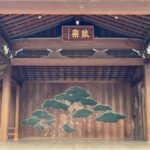
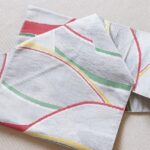
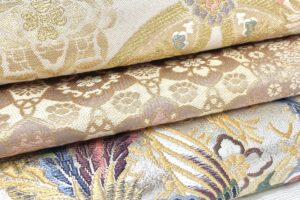


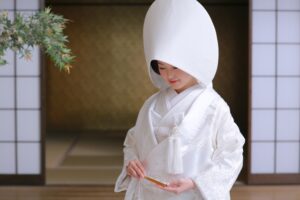

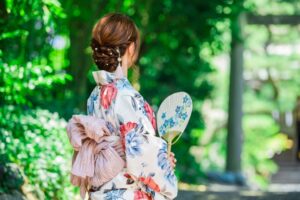
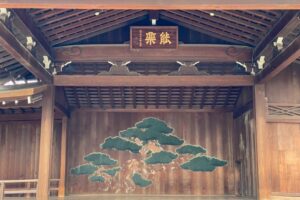
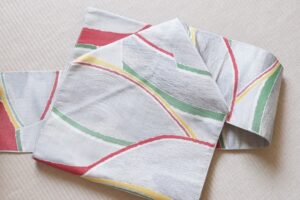
コメントを残す